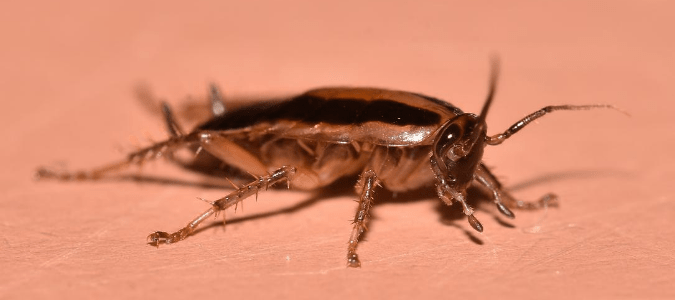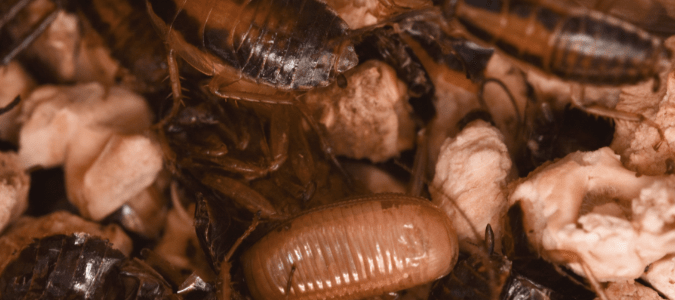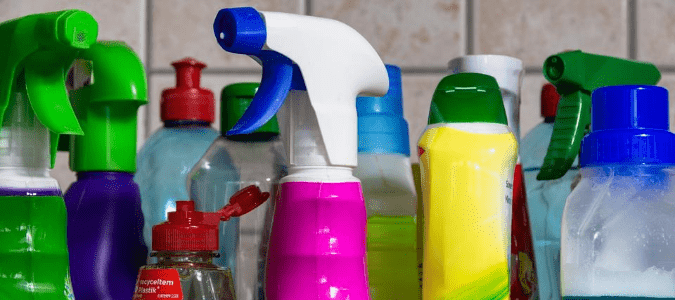
You turn on the light in the morning to get started with your day when you see a brown bug scurry out of sight. You’re pretty sure you just saw a cockroach, but, if you are being honest with yourself, you admit that you’re in denial. It could’ve been something else, right? After all, you work hard to keep your home nice and clean.
Well, the unfortunate truth is that cockroaches can make their way into even the tidiest of homes. And, while there are many different species of cockroaches, in general, these creatures are flat insects, and many species will have two pairs of wings that lay flat on their back. Their color ranges from light brown to black, and size can vary from as small as a half of an inch in length all the way up to two inches long. While finding a cockroach is never ideal, some infestations are worse than others. In fact, the species of cockroach you’re dealing with can play a huge role in determining how to most effectively go about exterminating them. Because of this, identifying what kind of cockroach you have spotted is the first step to addressing the problem.
The four main cockroach species that are common in the U.S. are:
- German cockroaches
- American cockroaches
- Brown banded cockroaches
- Oriental cockroaches
Let’s go into more detail about each species to help you hone your cockroach identification skills.
German Cockroaches
The German cockroach, pictured above, can reach up to three-quarters of an inch long. These roaches are light brown in color with two parallel dark brown stripes that run from their head backward. This species of cockroach has wings, but they cannot fly. German cockroach nymphs have wing pads and two dark stripes that extend down their whole body. Unfortunately, of all the cockroach species, the German cockroach is most likely to infest a home, and an infestation can get out of control very quickly.
American Cockroaches
American cockroaches are the largest cockroach species in the U.S. In fact, these creatures can exceed two inches in length in some cases. They are a reddish-brown color with a yellow figure-eight pattern on the back of their head. Unlike the German cockroach, American cockroaches can use their wings to glide through the air, which can be mistaken as flying. American cockroach nymphs are grayish-brown, but as they molt they turn redder. This species of roach prefers to be outside, but their flat bodies enable them to squeeze through cracks that are as small as 1/16 inch thick to get inside.
Oriental Cockroaches
Oriental cockroaches are large too, reaching one and a quarter-inch long. They are shiny, dark brown to black bugs that love water. They are commonly found in dark, moist, still places like drains and bathrooms. In humid, warm weather, you might find Oriental roaches near decaying organic matter, including next to a compost pile, clogged gutters or even a flower bed. A lack of moisture or cooler weather can drive these bothersome insects indoors through cracks along a home’s exterior or through plumbing. These creatures communicate by smell, which means you may notice a musty odor when you have a significant infestation.
Brown-banded Cockroaches
Brown-banded cockroaches are a smaller cockroach species that have two light brown bands across their dark brown body. Brown-banded cockroaches have wings as well, with the male having longer wings than the female. In general, these roaches grow to be about half an inch long. Identification of the brown-banded cockroach is important, as many people easily mistake this species for German cockroaches. The good news? Brown-banded cockroaches are less likely to invade your space than some other types. However, these pests can still become established in your home.
Size and color are the easiest ways to identify which species of cockroach you’re dealing with. Each variety is different in coloration, and they can vary significantly in size. Depending on the species, you’ll need to take different steps to remove them from your home.
American, German and brown-banded cockroaches are more likely to infest your home. They are drawn to food, humidity and dark areas. The most effective way to treat for roaches is to apply treatment solutions in the areas where they commonly congregate. If you go the professional route, your specialist will be able to locate the cockroach hiding spots and apply effective pest control solutions for you. Another benefit of enlisting the help of a pest control company is that technicians have access to products that homeowners do not, and these products are typically much more effective than what you can purchase yourself. If you want to try your hand at eliminating cockroaches yourself before calling in outside help, you’ll need to start by finding where the roaches are living.

How to Find a Cockroach Nest
To start, let’s get one misconception out of the way: cockroaches don’t necessarily build a nest like birds, bees or wasps do. Instead, they congregate in areas where they can stay out of sight. If you’re wondering where roaches hide, generally, you should look underneath appliances, in dark cabinets, behind large pieces of furniture and anywhere with close proximity to food or water.
As you get closer to cockroach hiding spots, you’ll find cockroach droppings, egg cases and dead bugs or empty skins. Droppings will look like anything from pepper-like specks to larger, mouse-dropping-shaped pellets. Larger droppings will have ridges down the sides. This feature helps distinguish cockroach pellets from mouse droppings. Cockroaches molt many times throughout their life, so finding these shed skins is an indication that there is an active infestation in your home. Even if you don’t spot the adult bugs, egg cases are a good way to tell if you have a cockroach infestation. Since egg cases are commonly glued to surfaces, they remain even after the eggs hatch.
Although cockroaches prefer to hide out of our sight, their nesting areas can vary, depending on the species you’re dealing with.
American cockroaches are commonly found near woodpiles, decaying trees, compost piles or sewer systems when living outdoors. When they infest homes, they hide in cracks and crevices during the day, and at night they are typically found in dark, moist areas, such as kitchens and bathrooms. On average, American cockroaches will produce at least one egg case a month, which will be glued to the wall in the nest or potentially near food sources like your cabinets. These cases typically have about 15 eggs in them, and the case itself will be about a quarter of an inch long and will look almost like a bean.
Oriental cockroach nests will be found near leaky pipes or in flooded basements. These roaches lay one to two light-brown colored egg cases per month which tend to be glued to surfaces near food. Their eggs and droppings are linked to musty smells in flooded or water-logged areas.
German cockroaches will be found in many more places than Oriental cockroaches because they can fit into tighter spaces. These roaches can lay up to 40 eggs at a time in their egg cases, which they deposit every two months. Additionally, they leave their eggs near food sources, which could be in drawers, on top of doors or even in the corners of your rooms. These eggs and feces smell particularly musty.
Finally, brown-banded cockroaches produce as many as one egg case every two weeks. They will hide their quarter of an inch, dark brown egg cases near food several weeks before they hatch. As a result, brown-banded cockroaches can repopulate an area more easily than other species. Hidden egg cases lead to nymphs hatching and once again infesting areas even if all adults have been removed.
Now that you know where to find the roaches, it’s time to figure out the best way to successfully treat these pest problems.

The Most Effective Cockroach Remedies
Getting rid of a cockroach infestation takes a lot of work. Cockroaches are one of the most resilient pests, they are prolific and they can eat nearly any organic matter, including cardboard, book bindings and even fingernail clippings. Eliminating a cockroach population requires significant, sustained efforts to make sure that the pests are gone for good.
There are many “home remedies” that people may recommend for getting rid of roaches. Unfortunately, they are typically ineffective and generally not scientifically proven. Roaches have thriven across the globe for millions of years and have evolved to be extremely resilient creatures. Also, due to their prolific breeding habits, natural remedies that can kill roaches often doesn’t harm enough of them to get rid of the whole population. For example, boric acid is often recommended as a roach control method. While this powder can actually kill roaches, it’s not a long-term solution and it does pose potential health risks to your furry family members. This also applies to other regularly suggested remedies like catnip or diatomaceous earth.
Despite what you might find suggested online, home remedies such as vinegar, herbs, cucumber and citrus are completely ineffective at killing roaches as well. In fact, these materials can act as food for these pests. And while essential oils may briefly repel roaches, this only works until the scent fades, and only for a small area. Additionally, the essential oils must be 100% pure and can be dangerous if accidentally ingested by pets or small children. Homeowners who experiment with these home remedies typically end up spending more time and money and get increasingly frustrated when none of their efforts prove successful.
If you do want to try a home remedy, the best place to start is roach traps. These devices typically contain slow-acting poison. The result is that cockroaches enter the traps, eat the poison, return to their nests and die. Traps are the most effective method of roach removal for one simple reason: roaches are very good at hiding. It’s essentially impossible to put down repellents or poisons in every place where the roaches live. Unfortunately, between the high reproduction rate of cockroaches and the hidden egg cases, even the most thorough do-it-yourself roach poison application will not fully control a pest population.
For your efforts to have the best chances of success, you’ll want to remove any water or food sources that the roaches could have access to so that they are drawn to the poisonous bait. Take the following steps to help control roaches:
- Seal all food, including pet food, in tightly sealed containers
- Wipe down stovetops, tabletops, kitchen and bathroom counters, appliances and coffee tables after use
- Sweep, mop and vacuum regularly
- Regularly empty trash bins into receptacles outdoors, especially before going to bed
- Clear dishes and put them in the dishwasher shortly after use
- Repair any leaking sinks or faucets
- Empty out pet food and water bowls at night
- Keep general clutter to a minimum
Of course, doing all this takes a lot of time. The fastest, most effective way to get rid of roaches in your home is always to contact a pest control company. Licensed technicians know the roach species that are most common in your area, what signs to look for and where the roaches most likely live. Working with a local pest control service is the quickest and easiest way to reclaim your home and successfully address a pest infestation.
ABC Can Get Your Roach Problem Under Control
Unfortunately, effectively dealing with a roach problem is often a long, involved project. Instead of struggling with home remedies while cockroaches continue to crawl across your counters, contact ABC Home & Commercial Services. Our highly-trained professionals will create a customized pest control solution for your home so you don’t have to spend your spare time worrying about these unwelcome visitors.